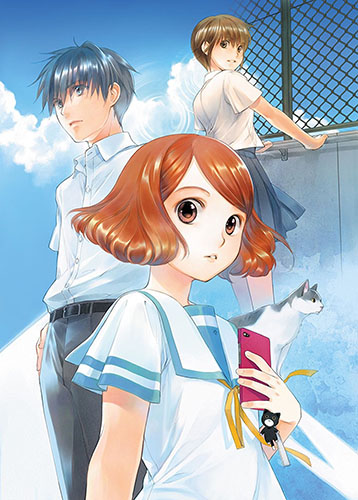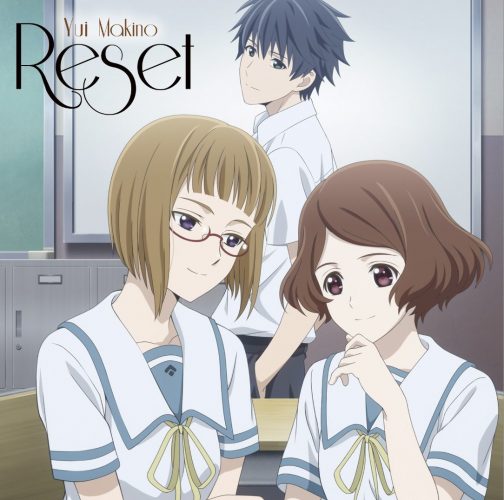
Pause. Save. Reset.
- Episodes : 24
- Genre : Mystery, Super Power, Supernatural, School
- Airing Date : April 2017 – September 2017
- Studios : David Production
Contains Spoilers
Sagrada Reset Introduction and Story (Spoilers)
Asai Kei is a teenager living in the hidden Japanese seaside town of Sakurada, a place where inhabitants are born with special abilities. Prompted by a letter he receives in his locker at school one day, Kei heads to the rooftop and meets the stoic Haruki Misora, a girl with the power to reset any and all events to a maximum of three days prior. This ability affects everybody including Misora herself, who is unable to remember whether or not she has reset. However, Asai Kei is the only person unaffected, a fact owed to his ability – an infallible memory. After helping someone by combining their powers, Kei and Misora decide to join the Service Club in order to help other people around town. Soon, their club becomes affiliated with the Administration Bureau, which manages abilities and events in the town of Sakurada to achieve their goals.
The two become the driving force of the anime’s main theme: righteousness. Throughout the initial episodes of the series, Misora and Kei are compared and likened. Kei initially believes it is because of people’s tendency to see both himself and Misora as very insincere people; however, the reality of it is that both are almost unnaturally altruistic – they help people on a simple whim and Kei has been proven to go to extremes in order to achieve this goal. Misora is initially seen to be extremely apathetic, but this is due to a childhood realisation that the world is filled with pain and sadness. Her detachment from emotion stems from her unbelievable empathy and it is this empathy that leads her to always Reset whenever she sees someone crying. Kei and Misora’s partnership turned friendship is what leads to both of their development throughout the series and their pairing is perfect in terms of what they hope to achieve, due to their matching personalities and complementary powers.
What We Liked About Sagrada Reset
Sagrada Reset’s greatest attribute is the philosophical nature of the show. From the jump, we are confronted with the main theme in the show – righteousness. Righteousness of the characters, righteousness of their actions. Characters in Sagrada Reset seem somewhat robotic at first glance; however, the anime seems to deliberately lay down extremely bland characters in the beginning in order to use the show to flesh them out. This is how each story arc is approached in Sagrada Reset and it is a method of storytelling that makes good use of each character to grow the individual character themselves, as well as Asai Kei and Haruki Misora.
Discussion Time
Sagrada Reset presents the theme of righteousness through one character’s telling of the story of a man called Gizen – “Hypocrisy”. Gizen spent the majority of his life helping other people due to the fact that he felt intense pain whenever he did not do so. Everyone benefitted greatly from his actions. Then one day, God created a copy of Gizen, a man called Zen – “Good”. Zen could not think for himself and chose to simply do what Gizen was doing. This posed the question: which one was truly Zen and which was Gizen? One’s answer to this question becomes evidence of their idea of what being good truly is. Asai Kei’s response became the evidence we needed to truly understand what kind of character he is. He answered that Zen was the true good in the story, due to the fact that he did good simply for good’s sake. From this exchange, we understand that Kei has a firm grasp on concepts of morality, as well as knowledge of his own self, as he does not regard himself as good. The story of Zen and Gizen draws very strong parallels to the pairing of Kei and Misora, and with that anecdote in mind, our approach of the series is carefully trimmed and curated.

Characters in Sagrada Reset have very clear-cut roles which are carefully mapped out in a way that makes them somewhat easy to understand, while maintaining a high level of complexity. Take the role of Souma Sumire, for example, Sumire sets off the entire plot by orchestrating Kei and Misora’s meeting, and it is Sumire who poses the philosophical question of Zen and Gizen to Kei. Her somewhat forward personality hides quite a dark history, as well as a crush on our main man, Asai Kei. All of this is painfully obvious, yet it is unravelled in a way which does not lose our attention. The main characters are of course, the most interesting due to the dynamic of their relationship.
Before meeting Kei, the only person with whom Misora has any notable interactions is Souma Sumire. However, after meeting Kei, Misora begins to open up and become a noticeably more expressive. Misora is often likened to an android or robot in the initial stages of the series and this notion is further augmented by Misora’s description of the three laws which govern the use of her powers – which, Kei notes, are reminiscent of the Three Laws of Robotics. Sagrada Reset’s use of various references and real-life ideas ground its characters in a somewhat whimsical realm of reality – their ideals, goals and personalities are quickly mapped out through use of these various concepts.
Speaking of these concepts which help expand the world of Sagrada Reset as well as its characters, it is worth noting that this is the type of series one should watch with the expectation to learn. The series is littered with interesting trivia which is always relevant to the characters or the storyline at hand – thus Sagrada Reset is an anime which entertains, enthrals, enchants and educates, aspects which we believe make it a good watch.
Sagrada Reset also does very well in terms of the way in which it deals with additional themes such as trust, what it means to be good and do good, as well as the innate complexity of human emotion, as well as the seemingly contradictory complexity of the lack thereof.

While being an anime driven by its characters, there seems to be something lacking where the characters are concerned. They feel very far from human in their views and interactions, especially the super straight-laced Asai Kei, a character with very little space for selfishness. His desire to help people goes to very dark extremes, such as when he deliberately slashes his own wrist in order to shock an adult into granting him the permission to help seven-year-old Kurakawa Mari, a young girl who was borne from her mother’s ability and was hence seen as a non-human by her parents. While this may be an element which is telling of Kei’s keen decision-making abilities and self-titled “selfishness”, it seems to push the boundaries of what anyone at that age would really put themselves through for “the greater good”. Perhaps the series was meant to explore notions of utilitarianism and what true ethical behaviour may be, but this came at the expense of various times where Kei could have been more than “the dude who is freakishly selfless”.
Another thing which gets completely ignored is the basic premise which sees characters harbouring powers in the first place – the reasons as to why are not explored and it would give a whole new dimension to the characters, the universe as well as the powers themselves. All that is explained is that people relinquish their powers, or the memory of their powers as soon as they leave Sakurada; however, the reason why is not explained nor is it even seen as a pertinent question by characters in the series. Thus, after finishing the series, anyone who does reflection on the series will notice this gap in their knowledge – if the series had explained the above the problems, perhaps it would be able to explain why different powers manifest differently in different characters.
Final Thoughts
Sagrada Reset uses various plot devices which we have seen several times before in order to drive its story; however, its focus is not on these devices, rather it is on the way in which the characters change and grow within their superpowered town. The presence of powers in the series is what facilitates the various philosophical discussions which the series explores and due to its heavy philosophical content, Sagrada Reset is a good watch for people who enjoy anime that is somewhat intellectually challenging. Given how the “Reset” ability is akin to time travel tropes which we enjoyed at a premium in 2016 with titles such as Re:Zero, Orange and Boku Dake ga Inai Machi (ERASED), Sagrada Reset is 2017’s take on that trope. As such, Sagrada Reset’s greatest achievement is owed to the fact that it uses tropes that are incredibly familiar in order to deliver a new experience, one characterised by the intensity of its moral questions, rather than the abilities of its characters. The show is definitely flawed in some ways; however, we believe that it is definitely worth the watch and there is much to learn from the series. So take a minute to pause and save, before this anime resets your mind to things you never quite had the time to think about.
Recommended Post
Sagrada Reset - Spring & Summer 2017 Anime
Recommended Post

